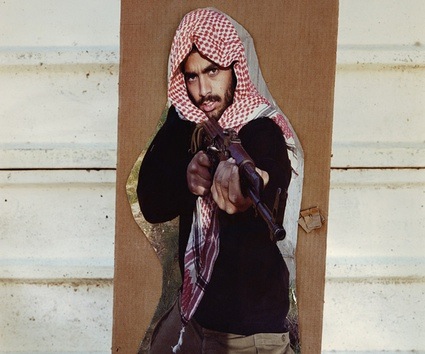 Adam Broomberg and Oliver Chanarin, Chicago #10
Adam Broomberg and Oliver Chanarin, Chicago #10
While i was in Nottingham for the Making Future Work events, i decided to take the bus to Derby and check out All that Fits: The Aesthetics of Journalism at QUAD. The exhibition postulates that art and journalism are two sides of a unique activity; the production and distribution of images and information.
Whereas journalism provides a view on the world, as it ‘really’ is, art often presents a view on the view, as an act of reflection.
The first part of the exhibition title, All that Fits, points directly to the New York Times’ moto “All the News That’s Fit to Print.” It asks us to think about what becomes of the information that doesn’t fit into the format or the agenda of a media outlet. Some of it is cut and customized to fit, some of it simply vanishes. But the information that doesn’t fit can also become the material and topic of artworks. And this is just as well since our faith in the impartiality and reliability of journalism has eroded over the past few years. At the same time, more artists have included activities such as inquiring, reporting and documenting into their portfolio while admitting that they are not bound by the same ‘reality’ constraints as journalists.
The works selected for the exhibition blend aesthetics and conceptual techniques we expect from artists with the methods and protocols that characterize the journalistic practice. They question the information rather than deliver it.
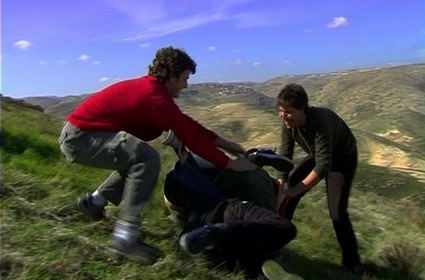 Yael bartana, Wild Seeds, 2005
Yael bartana, Wild Seeds, 2005
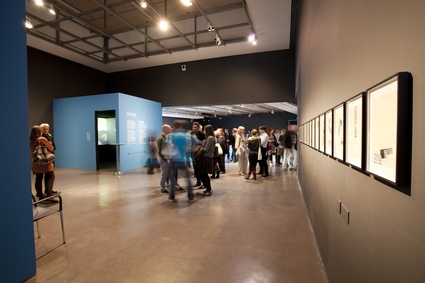 View of the exhibition space. Image courtesy of QUAD
View of the exhibition space. Image courtesy of QUAD
All that Fits: The Aesthetics of Journalism unfolds over three chapters: The Speaker, The Image and The Militant. The Speaker focused on the speaking subject or author, also in terms of editorial processes and camera angles. What can enable a subject to appear as authentic, authoritative and truthful? The Image examined how images are produced, through framing and positioning, but also how counter-images are created. Despite the claim of neutrality and pragmatism, this chapter proposes an ‘aesthetics of journalism’.
The third show opened yesterday. The Militant, continues the strand of counter-images, but by using journalistic means such as exposé and research. These methods often work to uncover what a corporate media industry does not, and thus return to some of reportage’s initial claims. Since the three shows overlap in content, with most works participating to 2 of the 3 chapters, i thought i’d fuse the three chapters into one post that looks more generally at the contemporary production of truth.
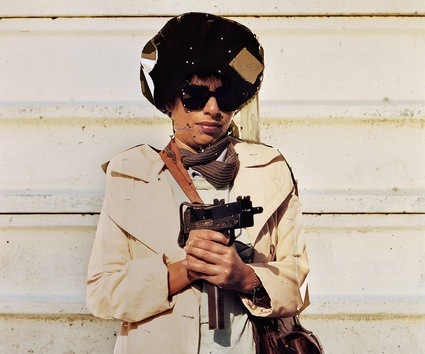 Adam Broomberg and Oliver Chanarin, Chicago #11
Adam Broomberg and Oliver Chanarin, Chicago #11
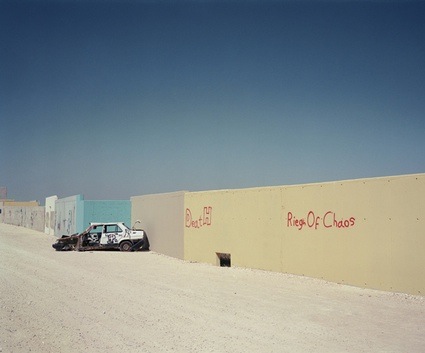 Adam Broomberg and Oliver Chanarin, Chicago #3
Adam Broomberg and Oliver Chanarin, Chicago #3
According to Adam Broomberg, “Photojournalism cannot be radical because it has to work within familiar patterns. It is politically ineffectual. Now museums and galleries are actually the place of radical, political work.” Together with Oliver Chanarin, he has been taking a lateral approach to documentary photography and information. For the Chicago series, for example, the duo has chose to stay “away from those immediate, heart-tugging images that suggest social concern” and focused instead on how the mechanism of the state worked.
Chicago is a fake Arab town built in the middle of the Negev desert by the Israeli Defense Force for urban combat training. “Everything that happened happened here first, in rehearsal”. All wars led and to be led by Israel in the future are practiced in the streets of Chicago, where the only human traces are photographs of Arab militia used for target practice. During the war in Lebanon, its labyrinth of streets and alleys were adorned with abandoned cars, imitating areas of Beirut. During the first and second intifada its concrete walls were covered with Arabic graffiti reminiscent of Gaza city, and an additional area was constructed to simulate the refugee camps of the occupied territories. During the first Gulf war American Special Forces had their first taste of the Middle East in Chicago in the Israeli desert.
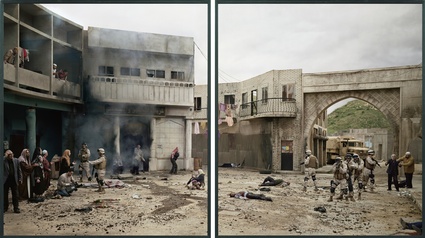 Eric Baudelaire, The Dreadful Details, 2006 (larger image)
Eric Baudelaire, The Dreadful Details, 2006 (larger image)
 View of the exhibition space. Image courtesy of QUAD
View of the exhibition space. Image courtesy of QUAD
In a carefully staged composition/scene, soldiers are pointing their heavy weapons at civilians, a mother is crying over a child that lays dead in her arms, other dead bodies are scattered around, there are traces of an explosion and tension is everywhere you look. Except maybe right between a menacing soldier and a civilian where a cameraman is quietly recording the scene.
In The Dreadful Details, Eric Baudelaire conveniently juxtaposed all the moments we expect to see in a war photo. The photo documents as much as it fakes a situation of war. Even the set is not genuine. It was created by a designer who has never set a foot in Iraq, his only cues were photographs from Time magazine.
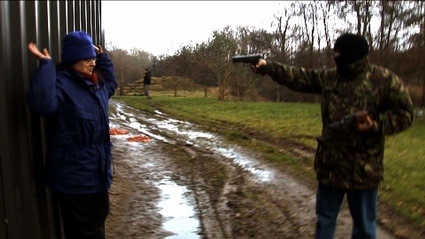 Oliver Ressler, The Fittest Survive
Oliver Ressler, The Fittest Survive
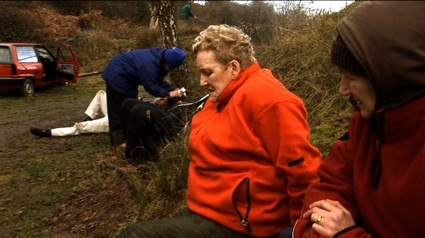 Oliver Ressler, The Fittest Survive
Oliver Ressler, The Fittest Survive
The most puzzling work in the exhibition is Oliver Ressler’s video The Fittest Survive. Actually it is not so much the video itself that is bizarre but its subject. The film follows the five-day course Surviving Hostile Regions done in January 2006 in Wales. The instructors, hired by a privately-owned security enterprise, are British ex-special force soldiers. The participants are businessmen, government officials and mainstream journalists who are put through conflict-situations in order to be ready for business in Iraq and other dangerous areas “that might otherwise have been closed to opportunity.”
The camera follows the participants as they experience the staged reality of live shell bombardments, an assault by armed guerrillas, the rescue of accident victims, and moving through mine fields.
As curator Elena Sorokina explained during her interview with the artist, The video brings attention to the current militarisation of businesses, and, less directly, to the increasing involvement of private business in warfare.
Unfortunately, i didn’t get to see the film Elimina, a totally Ghanaian production that stars the white American artist Douglas Fishbone. The film was scripted and shot by a leading Ghanaian production team, with a cast of Ghanaian celebrities. No reference is ever made of the fact that the artist clearly doesn’t belong in the movie. The project continues Fishbone’s investigation into the relativity of perception and understanding, pushing what audiences expect as the acceptable limits of role and representation in film.
The film will be released as a low-cost mass-market DVD and VCD in Africa and on African immigrant markets, The rest of us will be able to buy it as a limited edition in the art world.
Fishbone talks about his new Elimina to Tate.
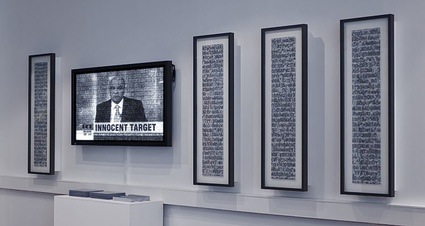 Michael Takeo Magruder, Insurance.AES256, 2011
Michael Takeo Magruder, Insurance.AES256, 2011
At the entrance of the exhibition, right by the ticket office, the curators have hung Insurance.AES256 by Michael Takeo Magruder, a project reflecting on issues of information freedom and secrecy in today’s media landscape. insurance.aes256 is the name of an insurance file released by WikiLeaks last year in connection with the Afghan War Diary disclosure. The insurance file was 20 times larger than the 77,000 secret U.S. military documents about Afghanistan that the non-profit organization had already published. The file generated considerable speculation and debate as no official explanation was given about its contents or purpose. Moreover, cryptographers declared that the file was virtually impossible to crack.
Whatever lies behind the mysterious insurance.aes256, it is now embedded into the fabric of the Internet as countless individuals and interested parties have now downloaded and redistributed it across hard drives and servers spanning the world’s file-sharing networks.
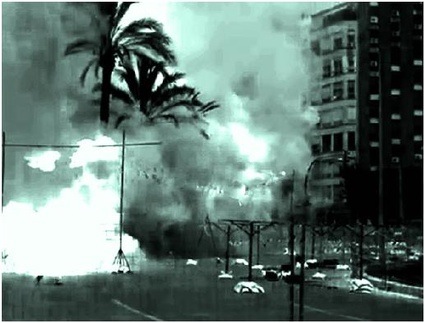
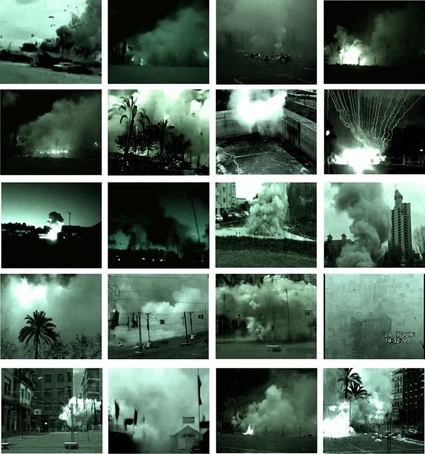 Alejandro Vidal, Somewhere in a Great Country, 2010
Alejandro Vidal, Somewhere in a Great Country, 2010
Alejandro Vidal‘s Somewhere in a Great Country is a series of video-captures found on the internet. Because they are devoid of any human presence and feature explosions, we are led to believe that the images document car bombings, acts of sabotage, war scenes, etc. In reality, they only record the moment when fireworks are used during celebrations of independence, festivals and political rallies.
All that Fits: The Aesthetics of Journalism is curated by Alfredo Cramerotti & Simon Sheikh and remains open at QUAD in Derby, England, until 31st July 2011.
Previously: Manipulating Reality – How Images Redefine the World and Manipulating Reality – The Day Nobody Died.
